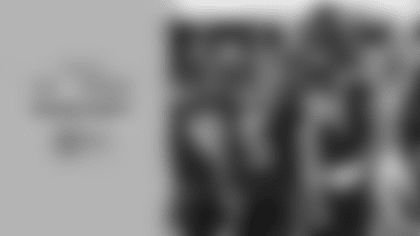With the NFL celebrating its 100th season, NFL teams are giving fans a chance to pick the most memorable play in franchise history. Once the choices are narrowed down to one play per team, there will be an online vote to determine the most memorable play in league history.
For the Seahawks, it shouldn't come as a surprise that three of the four choices are from playoff games during the Pete Carroll/John Schneider era, while the other involves one of the greatest players in franchise history exacting a little on-field revenge against a division rival.
Below are the four choices for the Seahawks' most memorable play, listed from most recent to oldest. Read more about each play, watch them again, then vote for your favorite at the bottom of the story.
Russell Wilson To Jermaine Kearse In Overtime Sends Seahawks To Second Straight Super Bowl
- 2014 NFC Championship
The first four times Russell Wilson targeted Jermaine Kearse, the Packers came away with an interception. It was that kind of afternoon for Wilson, Kearse and the Seahawks offense in January of 2015 as the defending Super Bowl champs looked to punch their ticket for a trip back to the Super Bowl.
While Seattle's defense came up with enough stops to keep the Seahawks in the game, the Packers led 16-0 at halftime, and by the fourth quarter Seattle's only touchdown came on a trick play, with Jon Ryan throwing a touchdown pass to Garry Gilliam on a fake field goal.
Not long after Wilson's fourth interception, the Seahawks got the ball back with 3:52 left in the game needing two touchdowns out of an offense that had yet to score one. But like all of Carroll's best teams, the 2014 Seahawks were a resilient bunch, a team that had overcome a 3-3 start by winning their final six regular season games to clinch the NFC West title and the NFC's No. 1 seed.
So despite so many struggles earlier in the game, Wilson, Marshawn Lynch and company were able to put together one touchdown drive, receiver Chris Matthews then recovered an onside kick, and Seattle found the end zone again, then gave themselves a 3-point lead on a wild 2-point conversion throw from Wilson to tight end Luke Willson. Those two points proved to be critical, because Aaron Rodgers and the Packers offense moved down field for a game-tying field goal that sent it to overtime.
The Seahawks started overtime with the ball, and after Wilson hit Doug Baldwin, who had turned the ball over earlier on a kick return, for a 35-yard gain to the Green Bay 35-yard line—Seattle's longest gain of the game—the stage was set for one of the biggest moments in franchise history. Despite Kearse's struggles in the game—two of the four interceptions had bounced off his hands—Wilson showed his faith in the undrafted player out of the University of Washington, going to him in the game's biggest moment. After recognizing a favorable look with no safety help in the middle of the field, Wilson checked out of the initial play to a deep shot down the middle, Kearse got a step on Green Bay corner Tramon Williams, Wilson threw a perfect pass, and Kearse secured his only reception of the game, the game-winning touchdown that sent Seattle back to the Super Bowl.
What followed was pure pandemonium—elation, tears, Michael Bennett on a Seattle Police bike—not just because the Seahawks were NFC champs, but because they had pulled off one of the most unlikely comebacks in NFL history.
"That's the best game I've ever been in for sure," Wilson said after the game. "I think that may be one of the best games in NFL history. Just to be able to come back in the playoffs like that and in overtime; I can't see a much better game than that."
Said cornerback Richard Sherman, who finished the game playing with one good arm due to an elbow injury, "It's kind of a microcosm of our whole season. It always seems like we're down and out and everything done, we're all out, there's no way to turn it around, then we find a way to turn it around."
"The Tip"
- 2013 NFC Championship
The Seahawks' NFC championship game victory over the 49ers was a battle of two NFC West heavyweights at their best, with two elite defenses trading blows against offenses led by dynamic young quarterbacks and potent rushing attacks. The game was close throughout—San Francisco's 10-0 first-half lead was the largest either team would enjoy in the game—and the Seahawks never led in the first three quarters before a 35-yard touchdown pass from Russell Wilson to Jermaine Kearse put the Seahawks ahead early in the fourth quarter. A Steven Hauschka field goal gave the Seahawks a 23-17 lead with 3:37 left, but the 49ers still had 3:37 left to try to score a touchdown against one of the best defenses in NFL history, a unit that led the NFL in scoring defense, total defense, passing defense and takeaways during the regular season.
Colin Kaepernick and company were able to move the ball as far as Seattle's 18-yard line with 30 seconds left on the clock, but that's when Kaepernick made a critical error. Kaepernick had all but avoided Richard Sherman's side of the field throughout the game, but with the outcome hanging in the balance, the 49ers quarterback decided to test Sherman with a pass intended for Michael Crabtree down the right sideline. Sherman read the ball the entire way, leapt, twisted and reached out with his left hand, batting it towards linebacker Malcolm Smith, who secured the game-clinching interception.
"When he tipped it, I was like, 'Oh God, the ball's been in the air forever,'" Seattle defensive end Michael Bennett said after the game. "Then Malcolm made a big play. … I was just like, 'Oh God, thank you so much.'"
The play and the victory would have been massive regardless of what came next, but part of what makes the play known as "The Tip" so memorable is that it helped send the Seahawks to Super Bowl XLVIII, which they won in dominant fashion over the Broncos, bringing the Lombardi Trophy to Seattle for the first time.
"BeastQuake"
- 2010 NFC Wild Card Playoff
While Richard Sherman's tip and Jermaine Kearse's overtime catch are massive plays in part because they sent the Seahawks to the Super Bowl, what might be the greatest play in franchise history, from a sheer degree-of-difficulty standpoint, came earlier in the Carroll/Schneider era.
When the Seahawks won the NFC West in 2010 with a 7-9 record, they came into the playoffs as more of a punchline than a serious contender, and few people outside of Seattle's locker room expected them to have a chance against the New Orleans Saints, who were the defending Super Bowl champions.
But when the game got underway, the Seahawks looked like anything but a pushover, with Matt Hasselbeck matching Drew Brees big throw for big throw as the Seahawks not only hung in with the defending champs, but took a lead late in the second quarter that they would never lose.
Hasselbeck threw for four touchdowns in what wound up being his final game at CenturyLink Field, but ultimately his big game was overshadowed by one play made by Marshawn Lynch late in the game.
Clinging to a 4-point lead, the Seahawks got the ball back with 4 minutes, 20 seconds left on the clock looking to keep the ball out of Brees' hands. Not surprisingly, the Seahawks put the ball in Lynch's hands, and the first play of the drive was an unremarkable run for no gain.
On second-and-10, the Seahawks called Lynch's number again, and, well, we’ll let him take it from here.
"We get into the huddle, and they call 17 power, I was like, 'oh my god, I've been trying to get in power for so long,'" Lynch told NFL Films years after the play. "With power, we're running straight downhill. You know where we're coming, and we know y'all are going to be lined up at, now you've just got to stop it. I'm saying I'm better than you."
When Lynch took the handoff, it looked like he might again be stopped for little to no gain, but then something magical started to unfold. Saints defender after Saints defender slid off of Lynch or were sent flying by stiff arms, and somehow, improbably, Lynch found himself diving into the end zone for a touchdown that all but secured the victory while also causing seismic activity that was detected by seismometers in the area.
The play needs to be seen, repeatedly, to be believed, but almost as entertaining is hearing Lynch describe the run to NFL Films: "I see the guard come around, and in my head I'm thinking backside A gap, but for some reason, it carried me to the front side. Bounced off the first tackle like, 'Uh-oh, might be trouble.' Split between (Chris) Spencer's block, coming off of (Darren) Sharper, he grabbed at my foot, I stayed up, I said, 'Uh-oh, it might be trouble.' Cover the ball with two hands, one of my old teammates, Jabari Greer came over the top, he slid off me; it's a good run now, but I'm like, 'Uh-oh, it might be trouble.' Tracy Porter came up, I gave him a little stiff arm, I stayed on my feet. We almost was running at top speed, so any kind of shove right there would throw a man off course. It was just a little baby stiff arm. A little baby stiff arm. (Alex Brown) came from behind, I took a little quick peek at him, gave him a little stiff arm, still didn't go down, 'Uh-oh, I know it's trouble.' Then next thing I know, Tyler (Polumbus) shot in front of me to go make a block on (Roman) Harper, dive into the end zone, touchdown. At the time I'm just thinking like, 'What the hell just happened? Did this really just happen?'"
It really happened, and it was instantly thrown into the conversation for being the best run in NFL history.
Lynch's run was significant not just because it helped the Seahawks win their first playoff game under Carroll, but because it was also in a lot of ways the beginning of Marshawn Lynch becoming the Marshawn Lynch Seahawks fans remember so fondly. After arriving in a trade earlier that year, Lynch was a big part of the offense, but he had yet to rush for 100 yards in a game prior to "BeastQuake." The next year Lynch would rush for 1,204 yards and 12 touchdowns, the first of four consecutive seasons in which he earned Pro-Bowl honors while gaining more than 1,200 yards and recording a double-digit touchdown total. Maybe that all happens regardless of what happened on that January night against the Saints, but the "BeastQuake" was quite the tone setter for Lynch and Seattle's running game going forward.
Steve Largent's Hit
- December 11, 1988
By the time the 1988 season kicked off, Steve Largent's legacy was already secure. Heading into what would be the penultimate season of a Hall of Fame career, Largent was a seven-time Pro Bowler and widely considered to be one of the best to ever play his position.
Yet despite all that, the 1988 season saw Largent add a memorable and unlikely chapter to his legendary career: one of the most memorable hits in franchise history.
In the Seahawks' opener at Denver, Dave Krieg tried to find Largent with a pass over the middle, but Broncos safety Mike Harden was there to meet Largent with a vicious hit, leveling the receiver with a forearm to the chin. The blow knocked Largent unconscious and cracked multiple teeth, leading to a fine for Harden.
Fourteen weeks later, the Broncos came to the Kingdome and the stage was set for a rather unlikely form of revenge. When Harden intercepted a Krieg pass in the end zone, his return was eventually halted by a brutal hit from none other than Largent. The violent but clean hit sent Harden airborne, the ball came out, and Largent pounced on the loose ball for the fumble recovery.
"That was the play I would say is my favorite play of my NFL career, a tackle, not a catch," Largent told NFL Films years later.
Younger Seahawks fans won't remember it, but Seahawks-Broncos was a good rivalry back when Seattle was in the AFC West, and that hit in a blowout win over the Broncos instantly became a highlight of the rivalry.






